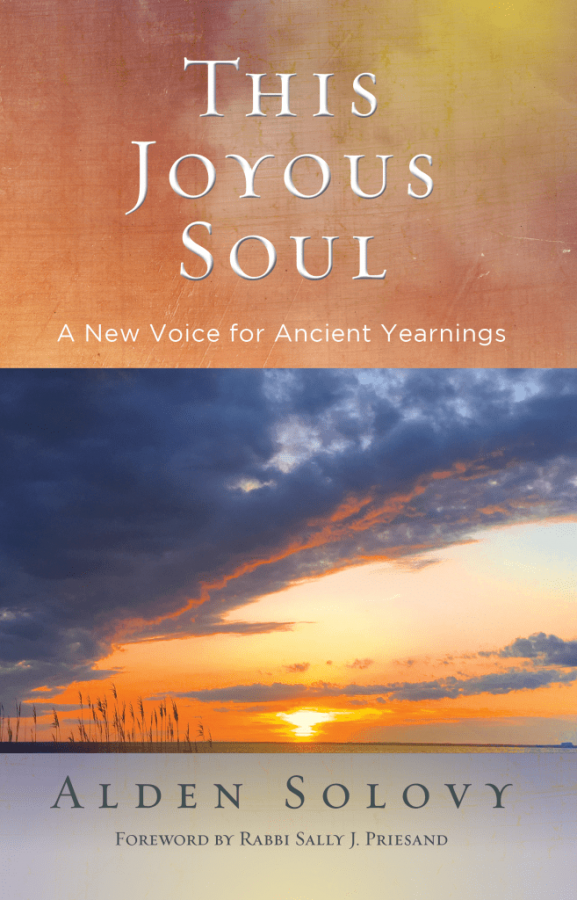The Amidah section in my copy of This Joyous Soul is a sea of dog ears
 The siddur is not merely a guide to the prayer service, but a narrative that takes us on a quest, as any good story should. This quest isn’t for a beloved, or a holy object, or the means to save the world; it’s a story of our search for a relationship with God, community, history and ultimately our souls. Ideally, by the end of the service, we are, even if only a little bit, transformed. There is great joy in this journey, and liturgist Alden Solovy explores this in depth in his new book, This Joyous Soul: A New Voice for Ancient Yearnings.
The siddur is not merely a guide to the prayer service, but a narrative that takes us on a quest, as any good story should. This quest isn’t for a beloved, or a holy object, or the means to save the world; it’s a story of our search for a relationship with God, community, history and ultimately our souls. Ideally, by the end of the service, we are, even if only a little bit, transformed. There is great joy in this journey, and liturgist Alden Solovy explores this in depth in his new book, This Joyous Soul: A New Voice for Ancient Yearnings.
In this important, useful and soulful collection, Solovy presents new prayers and poems through the structure of the siddur. Often, though not always, each section starts with a straightforward (pshat) version of a particular prayer. The section continues with each successive poem deviating more from the original, exploring and deepening different aspects and interpretations of the initiating prayer. Usually, this ends in one or more poems written in the first person. This technique of gradual spiritual, educational and personal expansion is also often used within the poem itself. At the beginning of the Birkot HaShachar section, Solovy’s first version of Modeh/Modah Ani, a meditation not on thankfulness but on the restoration of one’s soul upon wakening, he writes,
“I thank You, God,
Creator of life, Eternal One,
For restoring my soul to me with love
Filled with Your eternal trust.”
This is very close to an exact translation of the Hebrew prayer, but Solovy’s version doesn’t stop there. It continues on for eight more stanzas, each enlarging on what God restores for us. Each new stanza builds upon the last, from restoration of the soul to restoration of trust, hope, kindness, justice, mercy, peace and then, with all of that awakened, back again to one’s soul. It is a masterful use of the liturgical tropes of repetition and accumulation. Any prayer leader or teacher in need of an explanation of Modeh Ani and anyone in need of an inspiring kavannah could do no better.
After presenting the pshat version of a prayer, Solovy then offers a midrash on the prayer, and then what it means for him personally. So after his Modeh Ani we get “First Bird”:
“The first bird of morning
Sings alone
For the joy of breathing
For the glory of seeing,
For the love of being
Alive and awake
In this world…”
And later, “Your Dwelling Place”:
“Let my life become a temple,
A sanctuary of praise and service,
And You will dwell
In me.”
Clearly, Solovy finds his love and spiritual connection with God through the act of writing liturgy, and he shares that gift with his readers. Through his work, we experience the different ways we can approach God as the parent who loves us and looks after us, as our portal to morality and tikkun olam, as the Creator to whom we owe praise, as a friend and companion through our fears, our pains and our losses, as the Awesome Unknowable Presence and yes, even God as an idea, or The Idea, the inspiration for so many questions. In “The Details of Beauty” he writes,
“Remember
The details of love
With your breath
The soft smile
And gentle hand,
Small wonders to remind you
Of awe and majesty.”
Solovy looks to teach and enlighten. He understands how prayers work and what they are meant to accomplish as individual components and as part of a larger mission for the service as a whole. As I made my way through this book for the purpose of this review, I turned down a page corner whenever I found something I’d want to quote, and the Amidah section in my copy is a sea of dog ears. My favorite poem in this rubric was “Quiet,” in part because it took me to that moment during the Silent Amidah when I sometimes close the book and pray by listening to the quiet prayers of the others in the room: “Blessed are the gentle / moments of grace.”
Rabbi Sally Priesand’s Introduction to the book sums it up perfectly: “Let THIS JOYOUS SOUL feed your soul with the love of prayer. May the words of your heart lift you, shine within you, and bring you joy, comfort and peace.” Amen.
Trisha Arlin is a regular contributor to Ritualwell, a liturgist and very part-time rabbinic student at the Academy of Jewish religion; 2014 Liturgist-In-Residence at the National Havurah Summer Institute; the editor of RAISING MY VOICE: Selected Sermons and Writings by Rabbi Ellen Lippmann and VOICES, the Kolot Chayeinu Journal; and creator of the Writing Personal Prayer workshops. She blogs at: http://triganza.blogspot.com/.
Alden Solovy is an acclaimed liturgist of over 700 original works of Jewish liturgy. He recently taught an online course, through the Reconstructionist Learning Networks in collaboration with Ritualwell, entitled “Ingredients of Prayer: Writing Contemporary Liturgy.” His fourth book of new liturgy, This Joyous Soul: A New Voice for Ancient Yearnings, was recently published by CCAR Press. Alden blogs his latest prayers at www.tobendlight.com.






